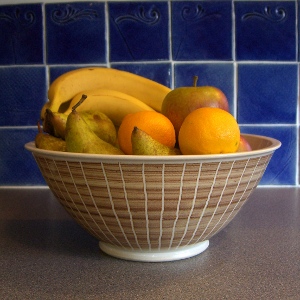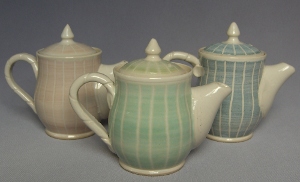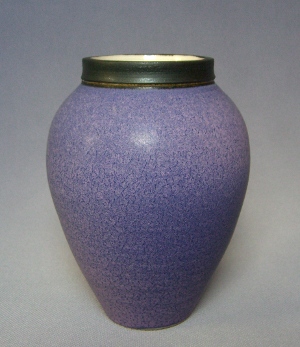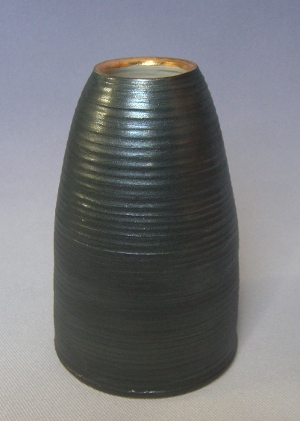 garlic pots
garlic pots
 I started making these pots in 1993. My mum had bought a simple terracotta garlic storage
pot and dropped it the first day she had it. I had not long been making pots but I thought
I ought to be able to do something and this is the design I came up with. The porosity of the
unglazed earthenware clay and the small holes ensure that the garlic doesn't sweat and go mouldy.
I started making these pots in 1993. My mum had bought a simple terracotta garlic storage
pot and dropped it the first day she had it. I had not long been making pots but I thought
I ought to be able to do something and this is the design I came up with. The porosity of the
unglazed earthenware clay and the small holes ensure that the garlic doesn't sweat and go mouldy.
I've been making them in small batches ever since. The making process is quite time consuming. Each one is thrown on the wheel and then the shape altered and carved with a wooden tool whilst still soft. The lid is cut from the base and I then paint three or four layers of a white slip (liquid clay) on the outside and rims. The red clay shows through in places, giving an interesting surface. It has been suggesed that I could slip-cast them - but the point is that I like the way they are all individual!
Because this is the only thing I make in red clay I have to clean up the wheel and all my tools
before and after making them, so I just do a batch every so often. They are popular so it is
best to check with me
that I have some before travelling. 
 domestic ware
domestic ware
 These pieces are wheel thrown and a layer of 'reactive' slip is brushed onto the leather-hard
clay. I incise lines through this slip, revealing the white clay below. After a first firing
they are glazed in a semi-transparent white glaze. In the glaze firing the slip reacts with
the glaze to produce interesting shades and textures.
These pieces are wheel thrown and a layer of 'reactive' slip is brushed onto the leather-hard
clay. I incise lines through this slip, revealing the white clay below. After a first firing
they are glazed in a semi-transparent white glaze. In the glaze firing the slip reacts with
the glaze to produce interesting shades and textures.
The work is fired to 1200°C, a low stoneware temperature. This makes it more resiliant than earthenware (which is what most domestic crockery is made from) and it can all be put in the microwave and dishwasher without fear of damaging it.
 I'm always happy to experiment with new colours but I develop my own slips
and glazes and will never offer to match an existing colour.
I have a standard range of shapes I make - but if you want a particular form, size or capacity
then please get in touch.
I'm always happy to experiment with new colours but I develop my own slips
and glazes and will never offer to match an existing colour.
I have a standard range of shapes I make - but if you want a particular form, size or capacity
then please get in touch.

 vases
vases
 The 'vase' or 'vessel' shape is one of the baselines for wheel-thrown ceramics
but I think it is more than that. It captures the essence of what pottery is
about for me: the enclosing of space and the giving of that enclosure a texture.
The form and the nature of the surface combine to convey some sort of feeling - an
emotion or a sentiment. Of course it's great that you can fill it with water and
stick a bunch of flowers in it too!
The 'vase' or 'vessel' shape is one of the baselines for wheel-thrown ceramics
but I think it is more than that. It captures the essence of what pottery is
about for me: the enclosing of space and the giving of that enclosure a texture.
The form and the nature of the surface combine to convey some sort of feeling - an
emotion or a sentiment. Of course it's great that you can fill it with water and
stick a bunch of flowers in it too!
These vases are just a sample - I'm continually playing with the line and the surface. The mottled purple is an experiment which pleases me at the moment. This glaze can produce anything from a flat matt purple/pink to a glossy royal blue with pink crystal dots.
 The black surface of this ribbed form was inspired by slate quarries in Wales, which
is where the roof tiles on our house in Kent come from.
The Romans mined for gold in Wales, which is found amongst seems of cloudy white quartz
and I'm starting to express something of that using lustres and other glazes.
The black surface of this ribbed form was inspired by slate quarries in Wales, which
is where the roof tiles on our house in Kent come from.
The Romans mined for gold in Wales, which is found amongst seems of cloudy white quartz
and I'm starting to express something of that using lustres and other glazes.


